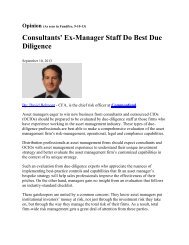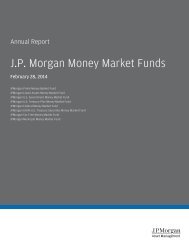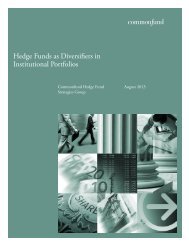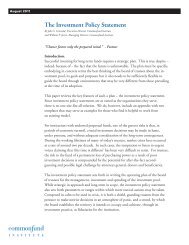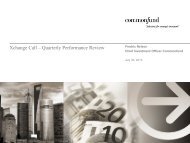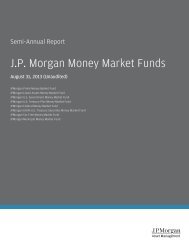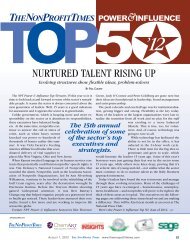Principles of Nonprofit Investment Management - Commonfund
Principles of Nonprofit Investment Management - Commonfund
Principles of Nonprofit Investment Management - Commonfund
You also want an ePaper? Increase the reach of your titles
YUMPU automatically turns print PDFs into web optimized ePapers that Google loves.
They could then calculate the payoutrate as a percentage <strong>of</strong> the investmentfund’s total net asset value. The overridingconsideration is the relevantsection <strong>of</strong> the Internal Revenue Codestipulating that foundations mustdistribute at least 5 percent <strong>of</strong> theirassets every year if they are to preservetheir status as tax-protected entities.The calculation <strong>of</strong> the 5 percent isbased on the average <strong>of</strong> the marketvalue <strong>of</strong> the foundation’s portfolio atthe end <strong>of</strong> each month <strong>of</strong> the previouscalendar year. Once that is known, thepressure is on to debit at least 5 percent<strong>of</strong> that average from the foundation’sbalance sheet and to make sure themoney has been spent – deposited intothe bank accounts <strong>of</strong> qualified grantees– by the end <strong>of</strong> the current year.Making this calculation even morecomplex are the regulations concerningattribution <strong>of</strong> administrative and overheadexpenses, as well as excise taxes.The calculation must be timely enoughto facilitate accounting and execution.Overhead and all other expenses mustbe precisely defined to determinewhich are attributable to distribution.Program expenses and staff time spentin grant making may be included.Meanwhile, another factor enters theboard’s deliberations about its distributionrate: the excise tax that the federalgovernment imposes. The tax amountsto 2 percent <strong>of</strong> annual net investmentincome and realized gains, unless totaldistribution reaches a certain tippingpoint which then brings the tax ratedown to 1 percent. Because the formulaused to determine qualificationsfor the reduced rate is so complicated,relatively few foundations apply forthe reduction. The new legislationproposes to reduce the rate to 1percent overall.As it has stood, the two-and-onepercent excise-tax formula has tendedto motivate foundation decisionmakers to raise their distribution ratehigher than they might have otherwise;better to pay more to grantees and lessin tax. The old tax formula could alsoinfluence decisions about when totake investment gains or losses.And so, the foundation’s financialteam determines its optimum course,weighing income, distribution andtax issues.To be sure, distributions are not theonly payout impacting a foundation’slife expectancy. Expenses related tomanagement <strong>of</strong> the foundation’sinvestments are counted outside <strong>of</strong>the distribution allotment.These include not only fees paid tooutside consultants and investmentmanagers but also related investmentoverhead expenses, e.g., administrativesalaries, space costs, and expenses <strong>of</strong>the board and investment committee.Inevitably, ambiguity arises. Someadministrative expenses are not clearlyclassifiable as part <strong>of</strong> either distribution,administration or investmentmanagement: certain costs <strong>of</strong> research,for instance, or conferencing. If a foundationsponsors a forum for grantees,is that counted as part <strong>of</strong> the 5 percentdistribution requirement?In recent years, new federal legislationhas been proposed (the timing <strong>of</strong>possible passage is unclear) that couldeliminate the attributable administrativeand overhead expenses that can now beincluded in the 5 percent total. Such alaw would tend to accelerate the rate <strong>of</strong>total payout <strong>of</strong> most foundations, possiblybringing some <strong>of</strong> them to depletionsomewhat sooner than they would haveplanned or wished.Aside from these pressures, a foundationmay be impelled by its mission todistribute more than 5 percent <strong>of</strong> itsassets. The needs <strong>of</strong> its grantees and theurgency <strong>of</strong> their work may demand it.A foundation so inclined must recognizeit may ultimately be limiting itstime horizon.- 12 -



